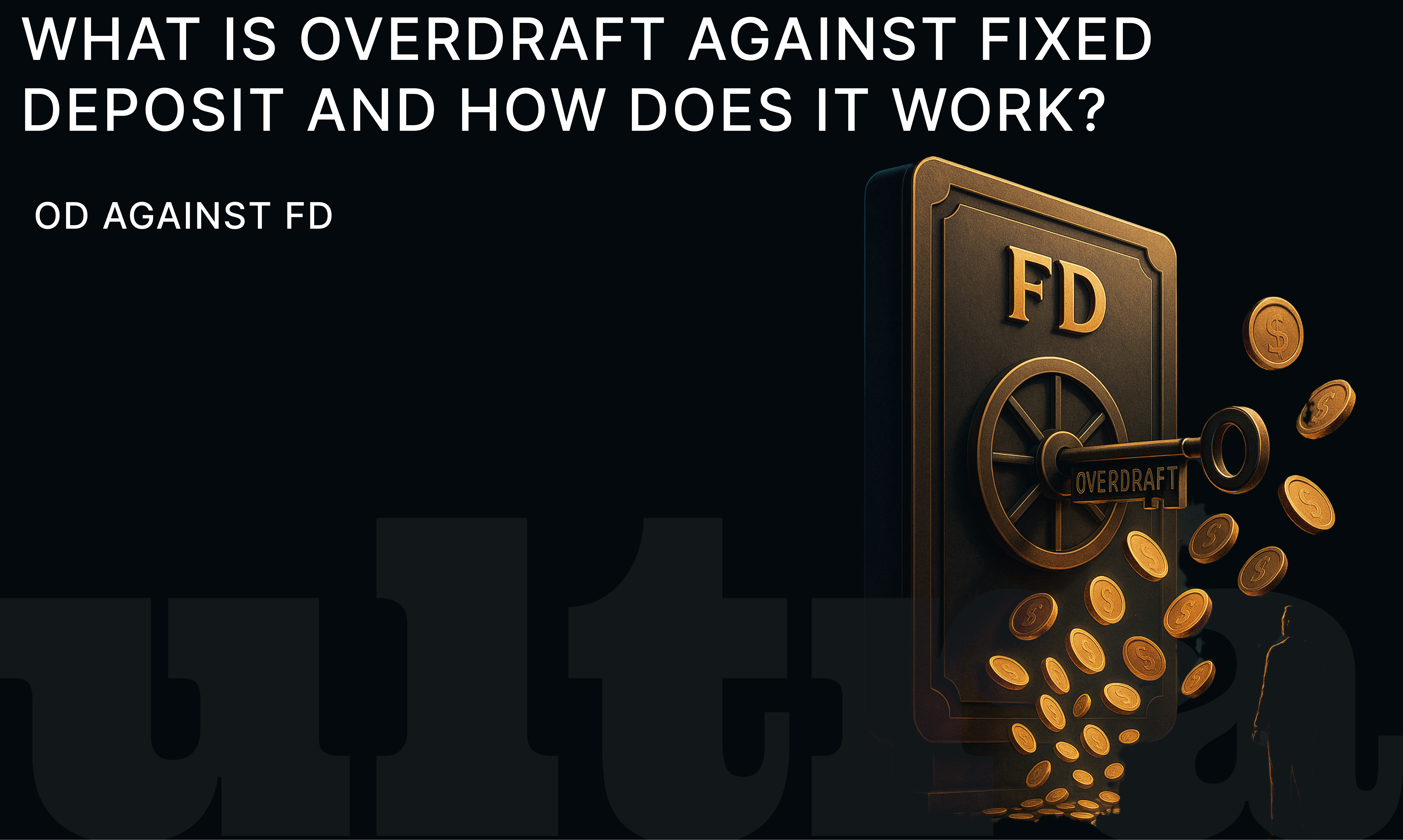OD Against FD: What is Overdraft Against Fixed Deposit and How Does It Work?
11 July 2025 · Sachin Gadekar
OD Against FD: How to Use Your Fixed Deposit for an Instant Loan.

What is OD Against FD?
At Ultra, we believe in helping investors find smarter ways to manage money. Many investors lock their savings in Fixed Deposits (FDs) for steady returns but end up liquidating them when urgent cash needs arise.
What if you could get immediate funds without breaking your FD and losing the earned interest? That’s where an Overdraft (OD) Against FD comes in handy.
In this guide, we explain what is OD against FD, how it works, its interest rates, eligibility, repayment, pros and cons, and how to calculate your overdraft limit.
OD Against FD, or Overdraft Against Fixed Deposit, is a secured loan facility offered by banks where you can borrow money against your existing FD without closing it.
In simple terms, your FD acts as collateral. Banks allow you to withdraw up to 75% to 90% of the FD amount as an overdraft limit. You can use the funds anytime and repay whenever you have surplus money. Interest is charged only on the amount utilized, not the entire limit.
How Does Overdraft Against FD Work?
Here’s how an OD against FD typically works:
You have a fixed deposit of ₹5,00,000.
The bank may allow you to take an overdraft of up to 90% — so your OD limit will be ₹4,50,000.
The FD remains active and continues to earn interest as usual.
You pay interest only on the amount you withdraw and for the duration you use it.
This makes OD against FD one of the most flexible ways to manage urgent liquidity without breaking your FD prematurely.
OD Against FD Interest Rate
One of the biggest advantages is the competitive interest rate. Since it’s a secured facility, banks usually charge only 1% to 2% higher than your FD rate.
Example:
If your FD gives you 6.5% annual return, the OD against FD interest rate may be 7.5% to 8.5%.
This is cheaper than unsecured personal loans or credit card advances, which can go up to 18%–36% p.a.
OD Against FD Calculator
Most banks provide an online OD against FD calculator on their website. Here’s how it works:
Enter your FD principal amount.
Enter your FD interest rate and bank’s margin rate.
The calculator shows the maximum eligible OD limit and the applicable interest rate.
For example:
FD Principal: ₹10,00,000
Eligible OD limit: 85% = ₹8,50,000
FD rate: 7%
OD interest rate: 8.5%
So, you can withdraw up to ₹8.5 lakhs and pay 8.5% p.a. interest only on the used amount.
Benefits of Overdraft Against FD
No Need to Break FD: Continue earning FD interest while using an overdraft for emergencies.
Lower Interest Rate: Cheaper than unsecured loans.
Flexibility: Use any amount within limit, repay anytime.
Quick Processing: Instant approval if you have an existing FD.
No EMI Burden: Pay interest only on utilized amount, no strict EMIs.
Eligibility for OD Against FD
You must hold an FD with the bank.
Most banks offer OD only to resident Indians (some allow NRIs too).
Joint account holders need consent from all holders.
OD limit depends on FD value and tenure.
OD Against FD vs. Loan Against FD
| Feature | OD Against FD | Loan Against FD |
|---|---|---|
| Repayment | Flexible, repay anytime | Fixed EMI schedule |
| Interest charged on | Utilized amount only | Entire loan amount |
| Withdrawal type | Multiple withdrawals | Lump-sum disbursal |
| Cost | Slightly lower | Slightly higher |
How to Apply for OD Against FD
Visit your bank’s branch or log in to internet banking.
Fill an overdraft request form mentioning your FD details.
Banks may require a lien marking on your FD.
Once approved, the limit is activated and can be withdrawn via cheque, ATM, or net banking.
Top banks like ICICI Bank, HDFC Bank, Axis Bank, and SBI offer hassle-free OD against FD services.
Should You Use OD Against FD?
An overdraft against FD is ideal if:
You need short-term funds for emergencies.
You want to avoid breaking your FD prematurely.
You want cheaper funds compared to a personal loan.
However, for long-term or big-ticket expenses, better alternatives may be:
Personal loan if you don’t have an FD.
Gold loan if you have gold assets.
Line of credit if you need revolving credit frequently.
FAQs on OD Against FD
1. What is OD against FD?
It is a facility where you can withdraw money as an overdraft using your fixed deposit as collateral, without closing the FD.
2. How is OD against FD interest rate calculated?
Banks charge 1%–2% above your FD rate. Interest is charged only on the amount used, not on the full limit.
3. How much loan can I get against FD?
Most banks allow you to withdraw 75% to 90% of your FD value.
4. Is there a penalty for OD against FD?
There is no penalty if you repay on time. However, overdue amounts can attract penal interest.
5. Is OD against FD better than breaking FD?
Yes. It helps you meet cash needs without losing your FD returns and avoids premature withdrawal penalties.
Final Thoughts
An overdraft against FD is a smart, quick, and low-cost way to handle short-term money crunches without disturbing your fixed deposits.
At Ultra, we always encourage investors to use available resources smartly — whether it’s OD against FD, low-risk bonds, or other fixed-income alternatives to grow wealth steadily.
Explore more such safe and smarter investments with Ultra.